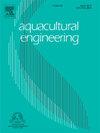Collection rates of detached mobile sea lice according to net mesh and body size: A benchtop model
IF 3.6
2区 农林科学
Q2 AGRICULTURAL ENGINEERING
引用次数: 0
Abstract
A variety of aquaculture activities, such as crowding and delousing treatments, can lead to mobile parasitic stages of salmon lice (Lepeophtheirus salmonis) and sea lice (Caligus elongatus) being detached from host salmon (Salmo salar) and entering the environment, where they may pose a reinfestation risk for farmed or wild fish. Here, we constructed a benchtop physical model to simulate the retention of detached mobile lice (L. salmonis and C. elongatus) within crowding nets of differing mesh sizes and mesh types: 0.8, 1.6 and 2.0 mm polyester square mesh, and catchLICE™ mesh, a nominal 2.0 mm hexagonal weave. Mesh types and louse classes (species, life stage, sex) were each measured according to standardized methods. The 0.8 mm square mesh retained all mobile life stages of both sexes (pre-adult I to adult L. salmonis, and adult C. elongatus), while the 1.6 mm square mesh retained all pre-adult II female and adult L. salmonis, but not all adult C. elongatus. The 2 mm square mesh and catchLICE™ mesh retained all adult female L. salmonis, with varying loss rates for all other louse classes. Measurements of the cephalothorax length, width and height of each louse stage indicated that size was not the sole determinant of collection success, as lice that might have fitted through the mesh openings were often retained, even after repeated ‘flushing’ flow events. Behavioural observations of lice grasping and crawling on the net surface may partly explain this discrepancy. Overall, finer-meshed crowding nets offer a partial solution to loss of lice during crowding, especially for the largest life stages.
根据网目数和身体尺寸分离的移动海虱收集率:台式模型
各种水产养殖活动,如拥挤和除虱处理,可导致鲑鱼虱(Lepeophtheirus salmonis)和海虱(Caligus elongatus)的移动寄生阶段从宿主鲑鱼(Salmo salar)上分离并进入环境,从而可能对养殖或野生鱼类造成重新繁殖的风险。在这里,我们构建了一个台式物理模型来模拟在不同网目尺寸和网目类型的拥挤网中分离的移动虱子(沙门氏菌和细长虱)的滞留:0.8,1.6和2.0 mm聚酯方形网,以及catchLICE™网,名义2.0 mm六角形编织。按标准化方法测定网目类型和虱类(种类、生活阶段、性别)。0.8 mm方网布保留了两种性别的所有活动生命阶段(I期至成虫和长柄沙门菌),1.6 mm方网布保留了所有II期前雌沙门菌和成虫,但未保留所有长柄沙门菌成虫。2 平方毫米网和catchLICE™网保留了所有成年雌性沙门氏菌,所有其他虱类的损失率各不相同。对每个虱子阶段的头胸长度、宽度和高度的测量表明,大小并不是收集成功的唯一决定因素,因为虱子可能已经通过网格开口,即使在反复的“冲洗”流事件之后,它们也经常被保留下来。对网面上虱子抓取和爬行的行为观察可以部分解释这种差异。总的来说,细网拥挤网提供了部分解决方案,在拥挤期间虱子的损失,特别是在最大的生命阶段。
本文章由计算机程序翻译,如有差异,请以英文原文为准。
求助全文
约1分钟内获得全文
求助全文
来源期刊

Aquacultural Engineering
农林科学-农业工程
CiteScore
8.60
自引率
10.00%
发文量
63
审稿时长
>24 weeks
期刊介绍:
Aquacultural Engineering is concerned with the design and development of effective aquacultural systems for marine and freshwater facilities. The journal aims to apply the knowledge gained from basic research which potentially can be translated into commercial operations.
Problems of scale-up and application of research data involve many parameters, both physical and biological, making it difficult to anticipate the interaction between the unit processes and the cultured animals. Aquacultural Engineering aims to develop this bioengineering interface for aquaculture and welcomes contributions in the following areas:
– Engineering and design of aquaculture facilities
– Engineering-based research studies
– Construction experience and techniques
– In-service experience, commissioning, operation
– Materials selection and their uses
– Quantification of biological data and constraints
 求助内容:
求助内容: 应助结果提醒方式:
应助结果提醒方式:


